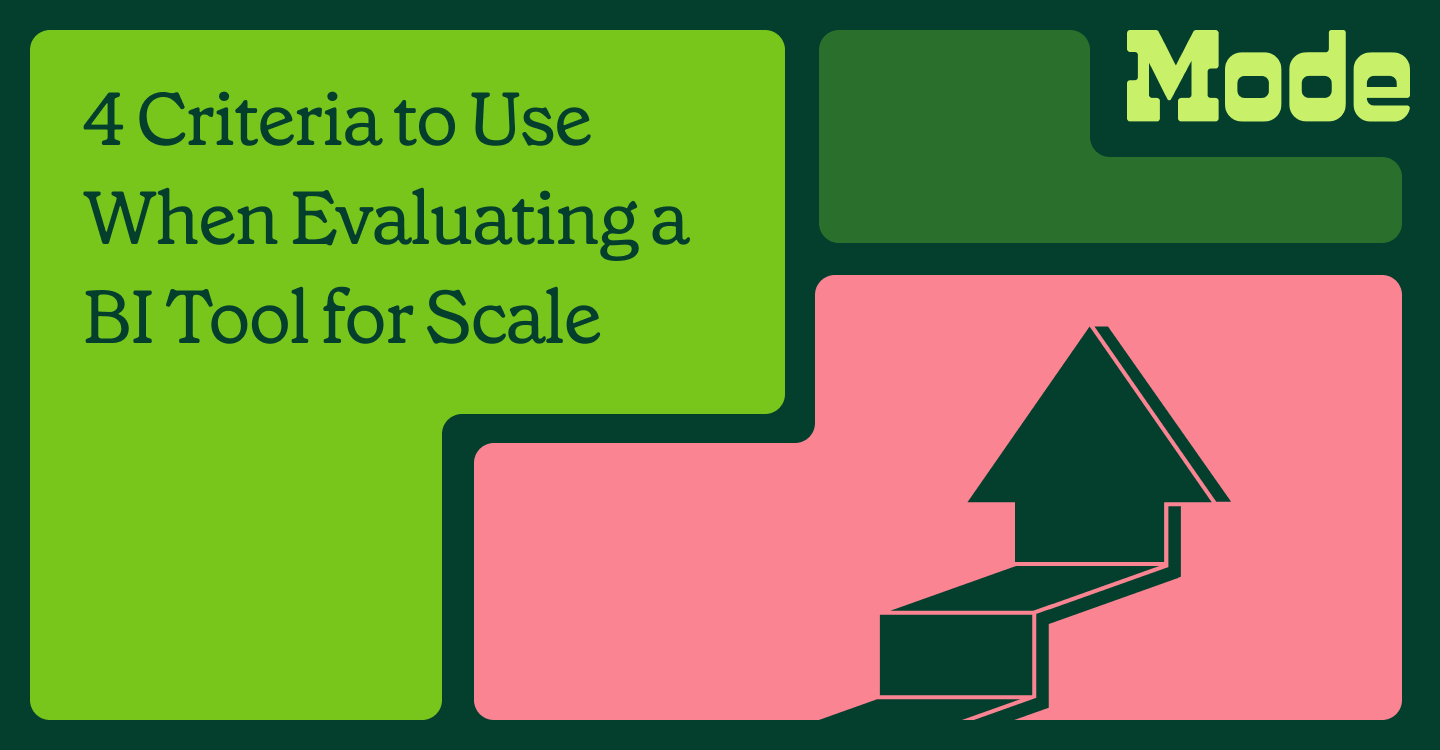4 Criteria to Use When Evaluating a BI Tool For Scale

Chioma Dunkley, Mode Team Writer
May 5, 2022
NaN minute read

The right analytics tool can accelerate data-driven insights at any organization.
For data analysts who are working with spreadsheets and have no previous analytics tooling, the productivity level of an analytics tool can be monumental.
The data workflow can be drastically condensed by cutting down the process of switching back and forth between SQL Editors, Python or R Notebooks, Github, and CSVs. Brand new insights can be generated by bringing lots of disparate data together (like product and marketing) and your analytics tool can help democratize data over time, letting analysts focus on strategic questions while stakeholders answer their own.
For data teams looking to upgrade their analytics tools, it’s not about just choosing a more modern option for the data team, but also choosing a tool that makes it easy for stakeholders to join in on the analysis.
For the entire organization, an analytics tool can act as a trusted single source of truth for company KPIs and department dashboards as data needs start to grow, helping the entire company operate on data faster.
When is it time to consider a BI tool?
If you are struggling to bring together and analyze data, it’s probably a sign you need an advanced analytics tool. But what happens if when your company begins to evolve, and with that growth, a resurfacing of new data roadblocks? What you need is not just any analytics tool, but an analytics tool you can grow with.
A BI tool needs to be flexible to scale
Broadly, it looks like having a flexible enough analytics tool that can help with short-term and long-term business goals; it means that you’re able to start right where you are, at whatever stage of data maturity you’re in, and drive data insights across an organization quickly.
More specifically, it means being fast enough and complex enough for data teams to use as they mature, and approachable enough for stakeholders to access and explore data on their own.
Download now

How to Lead from The Center: A Guide for Data Leaders
Learn how to unlock a trusted data experience across your org.
How to evaluate a BI tool for scale
An efficient workflow for the data team - Data teams need technical workflows that let them run a SQL query, pull it into Python or R and turn the results in visualizations that they can share with stakeholders. This should be able to be done all in a single platform.
Mode provides an all-in-one workflow for analysts that makes it easy to bring all of your data together in one place. By combining an SQL Editor, Python & R Notebooks, and visualizations powered by our in-memory data engine, Helix, Mode helps analysts work fast in a single place without jumping into different tools.
Can you bring all of your data into one platform? When data lives in different platforms, answering data questions becomes a slow, disjointed process and way more difficult than it has to be.
When you’re first starting out, you might have data in different tools. In Mode, you can bring data from different sources like Google Analytics, Salesforce, Intercom, Marketo—to name a few—into one place for more comprehensive analysis. Once your data is loaded into a database like Snowflake, Redshift, Google BigQuery, PostgreSQL, you can access it in Mode, cleaned or raw, to get a more complete picture with data from across departments.
1. Collaboration features, so you can work on data with business teams and stakeholders
Great analysis almost always needs to be informed by others. With governed data exploration for stakeholders, it’s easier to collaborate on analysis within your data team and across departments in Mode.
With Explorations, and features like drilldowns, filters, and calculated fields, Mode provides a user-friendly space where stakeholders can take action on data insights and run analysis themselves without having to write any code and without affecting the underlying code–making it simpler for other team members in like marketing, product, customer, and others to join in on the data conversation.
Mode’s Visual Explorer helps team members and stakeholders create their own visualizations and answer their own questions with chart types they’re familiar with like pivot tables, scatter plots, and funnel charts.
2. Easy data-sharing and distribution capabilities
Data insights are not just for the data team. Insights need to be shared across the company to influence decision-making and meet company KPIs. Mode makes it easier for data to be shared with permissions settings within and outside of the data team.
Embed data where your team members are. With Internal Embeds and White-Label Embeds, you can share reports across various platforms internally and externally. You have the ability to share reports on your website, on a blog, or in other platforms like Salesforce.
With Mode’s many integrations you can make important data more accessible at the time they need it most. With integrations like our Slack integration, you can drop reports and charts directly into communication channels.
Mode’s Scheduled runs functionality allows you to automate reports so that queries can call themselves—cutting down on your team's manual tasks.
3. Powerful and customizable visualizations for self-serve insights
The more visualization types you have to explore a dataset with, the more context you can get about a question. Great visualizations help you see trends clearly and give you a deeper understanding of what's happening.
Mode lets you create a variety of visualizations that offer an array of charts and styling capabilities that appeal to both technical and non-technical colleagues in your company.
You can make branded or customized data visualizations that provide even more context and tell a better story.
4. Data security measures to protect sensitive data
Whether you’re sharing data with different teams, managing exceptionally sensitive data, or getting ready to go through stage 2 compliance, data security is always top of mind. Mode helps you secure your data both internally and externally.
Mode helps ensure that data is secure both in your company and within our platform with industry-level security.
For department-sensitive data, Mode allows you to set permissions and control privacy settings on individual reports so that you can share data within your team without jeopardizing sensitive information. You can establish data governance, or business logic and data management practices, in Mode’s platform. Enhanced with our dbt integration, you can make sure data is reliable and consistent.
Grow your data initiatives with Mode
As your company grows, so do the data demands. The right analytics tool can help data teams build and nurture a data-driven culture, create stronger alignment between teams with data-driven decisions, and help businesses make better decisions, faster.
If you want to learn more about how Mode can help scale your analytics initiatives, schedule a call with us or read how some of our customers have scaled their data impact with Mode.
Get our weekly data newsletter
Work-related distractions for data enthusiasts.




